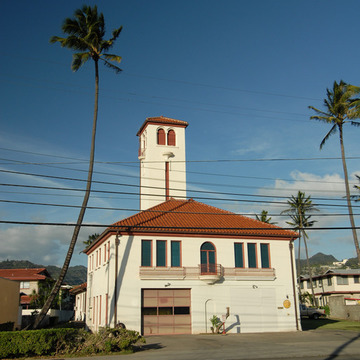Following the lines of the popular Spanish Mission style of the 1920s, the fire station remains a prominent landmark in this section of town, with its sixty-foot tower, vivid red tile roof, and contrasting cream-colored stucco walls. In addition to conferring a sense of status on the building, the tower functioned as a space to hang the cotton-sheathed rubber hoses to dry; with the advent of nylon hoses, the tower became strictly decorative. The Kalihi station is one of four fire stations erected during the prosperous years between 1924 and 1929. They all follow a similar plan and design. The others are the Kaimuki Fire Station on Koko Head Avenue, the Makiki Fire Station on Wilder Avenue, and the Kakaako Fire Station on South Street. Whereas the Kaimuki and Makiki stations replaced earlier wooden buildings, the construction of the Kalihi and Kakaako stations signified the need for increased fire protection in these growing districts.
Architect Robert G. Miller (1890–1953), a native of San Francisco, came to Honolulu in 1911, where he was employed as a draftsman in Thomas Gill's office. After serving in World War I, he returned to Hawaii and entered into partnership with Ernest J. Flores in 1919. Two years later he opened his own office. He was well known in the 1920s and 1930s for his works in a Spanish vocabulary. In addition to the Kalihi Fire Station, he also designed the Kaimuki Fire Station, Honolulu Hale (OA62), and numerous houses.







